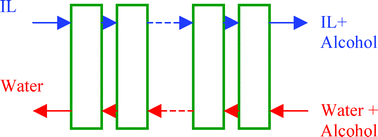Ethanol production in the U. S. has increased 36% between 2006 and 2007 (J. M. Urbanchuk, Contribution of the Ethanol Industry to the Economy of the United States, LECG, LLC, Renewable Fuels Association, 2008) in response to a growing demand for its use as a commercial transportation fuel. 1-Butanol also shows potential as a liquid fuel but both alcohols require high energy consumption in separating them from water. 1-Butanol, in particular, is considered an excellent intermediate for making other chemical compounds from renewable resources, as well as being widely used as a solvent in the pharmaceutical industry. These alcohols can be synthesized from bio-feedstocks by fermentation, which results in low concentrations of the alcohol in water. To separate alcohol from water, conventional distillation is used, which is energetically intensive. The goal of this study is to show that, using an ionic liquid, extraction of the alcohol from water is possible. Through the development of ternary diagrams, separation coefficients are determined. The systems studied are 1-hexyl-3-methylimidazolium bis(trifluoromethylsulfonyl)imide/ethanol/water, which exhibits Type 1 liquid–liquid equilibrium (LLE) behavior, and 1-hexyl-3-methylimidazolium bis(trifluoromethylsulfonyl)imide/1-butanol/water, which exhibits Type 2 LLE behavior. Based on the phase diagrams, this ionic liquid (1-hexyl-3-methylimidazolium bis(trifluoromethylsulfonyl)imide) can easily separate 1-butanol from water. It can also separate ethanol from water, but only when unreasonably high solvent/feed ratios are used. In addition, we use four excess Gibbs free energy (gE) models (NRTL, eNRTL, UNIQUAC and UNIFAC), with parameters estimated solely using binary data and/or pure component properties, to predict the behavior of the ternary LLE systems. None of the models adequately predicts the Type 1 system, but both UNIQUAC and eNRTL aptly predict the Type 2 system.
